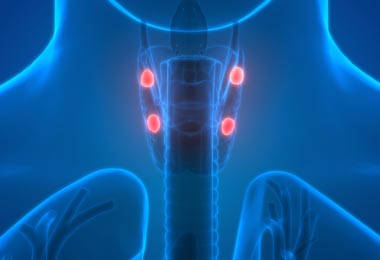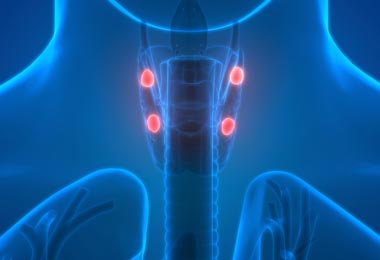Postpartum Thyroiditis
What is postpartum thyroiditis?
Postpartum thyroiditis happens when a person’s thyroid gland becomes inflamed within 1 year of delivering a baby or having a miscarriage or abortion. This condition affects a small percentage of pregnant people.
The thyroid is a tiny, butterfly-like gland in the front of your neck. Its job is to make thyroid hormones. These hormones travel through your blood to all parts of your body. Thyroid hormones control how your body makes and uses energy (your metabolism). They affect almost every organ in your body. When your thyroid doesn’t make the right amount of hormones, you don’t feel well.
Postpartum thyroiditis may first make your thyroid overactive (hyperthyroidism). This means it sends too many thyroid hormones out into the bloodstream. This can make parts of your body work too fast. But over time, the condition can lead to an underactive thyroid (hypothyroidism). This means it doesn’t make enough thyroid hormones. Then, parts of your body slow down, including your metabolism. Postpartum thyroiditis symptoms can also be attributed to postpartum depression or the stress of being a new parent. This is why it is important to see your healthcare provider for a diagnosis.
What causes postpartum thyroiditis?
Experts don’t know what causes this condition. But it is a lot like the autoimmune disease Hashimoto thyroiditis. It is hard to tell the 2 conditions apart.
Who is at risk for postpartum thyroiditis?
You may be more likely to get this condition if you have any of these:
-
Antithyroid antibodies before pregnancy
-
Type 1 diabetes
-
A history of thyroid problems
-
Family history of thyroid problems
-
Other autoimmune conditions, including rheumatoid arthritis, etc.
What are the symptoms of postpartum thyroiditis?
When the thyroid becomes inflamed, it first sends a lot of thyroid hormone into your blood. That causes hyperthyroidism. During this time, you may not have any symptoms. Or you may have any of the symptoms listed below under overactive thyroid.
After this first phase, you may fully recover. Or your thyroid may be damaged. A damaged thyroid can become underactive. This condition may also go away. Or you may have an underactive thyroid for the rest of your life. In this case, you may need hormone replacement.
Each person’s symptoms may vary. Symptoms may include:
Overactive thyroid (hyperthyroidism)
-
Feeling warm or sweaty
-
Muscle weakness
-
Nervousness or anxiety
-
Fast heartbeat, palpitations
-
Loss of focus
-
Weight loss
Underactive thyroid (hypothyroidism)
-
Extreme tiredness and lack of energy (fatigue)
-
Constipation
-
Memory loss
-
Feeling abnormally cold
-
Muscle cramps
-
Weakness
-
Weight gain
These symptoms may not appear until a few months after childbirth. They may be mistaken for normal signs of recovery from childbirth. Always see your healthcare provider for a diagnosis.
How is postpartum thyroiditis diagnosed?
Tests used to diagnose postpartum thyroiditis depend on the phase of the disease. A blood test that measures thyroid hormone levels can often tell if you have an overactive or underactive thyroid.
How is postpartum thyroiditis treated?
Treatment will depend on your symptoms, age, and general health. It will also depend on how severe the condition is.
Treatment depends on the phase of the disease and your symptoms:
-
Overactive thyroid. If you have major symptoms of hyperthyroidism, your healthcare provider will often prescribe beta-blockers. These medicines slow down your heart rate.
-
Underactive thyroid. If you have major symptoms of hypothyroidism, your provider will prescribe a thyroid hormone replacement called levothyroxine.
You should have regular thyroid tests. Your thyroid may be working normally within 12 to 18 months after the symptoms start. If so, you may be able to stop treatment. Thyroid function will return to normal in 4 in 5 people.
If you are in a high-risk group for developing postpartum thyroiditis, your provider may check for thyroid hormone abnormalities. They may do this 3 or 6 months after your delivery.
Key points about postpartum thyroiditis
-
Postpartum thyroiditis happens when a p’s thyroid becomes inflamed after delivering a baby or having a miscarriage or abortion. It may first cause the thyroid to be overactive. But in time, it can lead to an underactive thyroid.
-
Experts don’t know what causes this condition.
-
You are more likely to get it if you had antithyroid antibodies before pregnancy. Other risk factors include having type 1 diabetes, a history of thyroid problems, or another autoimmune condition.
-
A blood test to check thyroid hormone levels can often tell if you have an overactive or underactive thyroid.
-
Treatment is based on how severe your symptoms are.
Next steps
Tips to help you get the most from a visit to your healthcare provider:
-
Know the reason for your visit and what you want to happen.
-
Before your visit, write down questions you want answered.
-
Bring someone with you to help you ask questions and remember what your provider tells you.
-
At the visit, write down the name of a new diagnosis and any new medicines, treatments, or tests. Also write down any new instructions your provider gives you.
-
Know why a new medicine or treatment is prescribed and how it will help you. Also know what the side effects are.
-
Ask if your condition can be treated in other ways.
-
Know why a test or procedure is recommended and what the results could mean.
-
Know what to expect if you do not take the medicine or have the test or procedure.
-
If you have a follow-up appointment, write down the date, time, and purpose for that visit.
-
Know how you can contact your provider if you have questions.
Seminar Webinar: Thyroid Disease, an Often Surprising Diagnosis

Join endocrinologist Paul Ladenson, M.D., as he outlines the signs and symptoms of the various thyroid disorders and discusses the interplay among other diseases and the thyroid. The webinar recording is presented as part of A Woman’s Journey Conversations That Matter webinar series.




